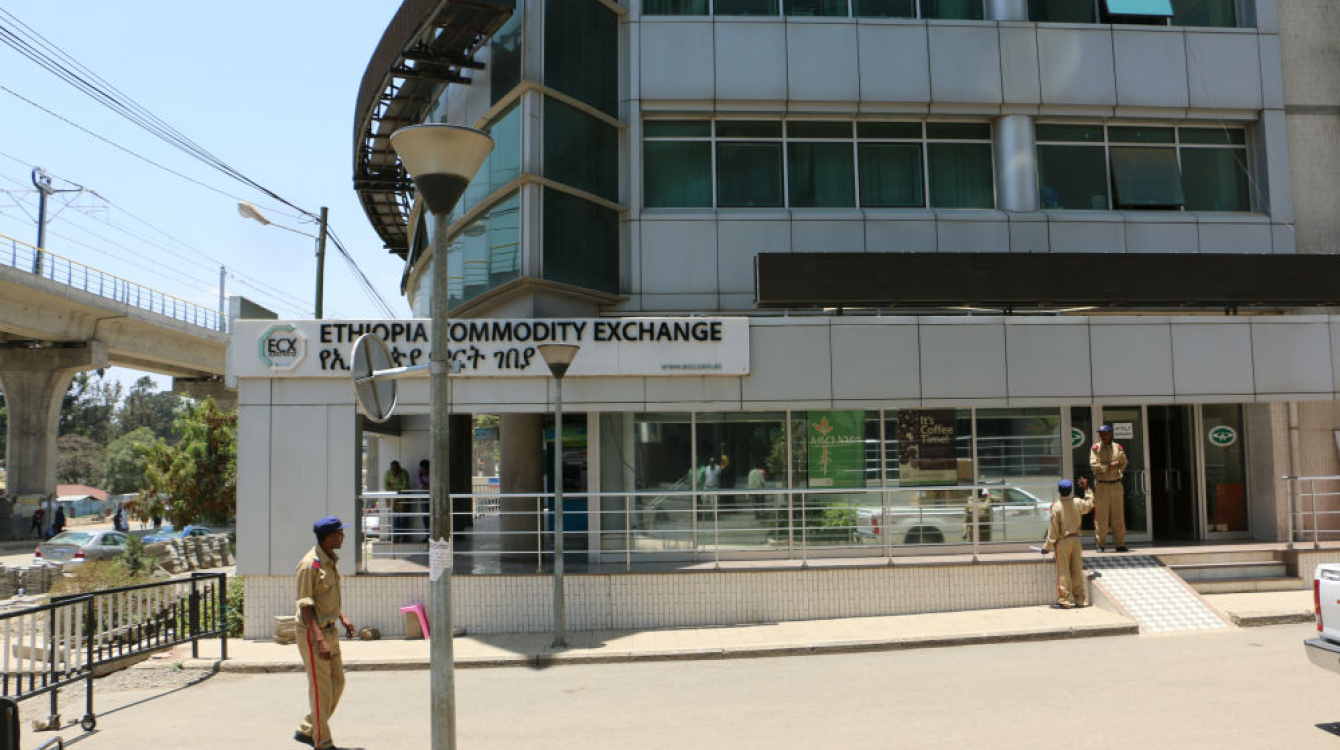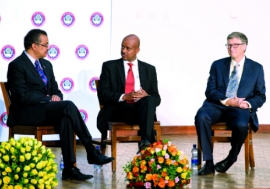Ethiopia: fixing agriculture
Ethiopia: fixing agriculture
Early this year Masimba Tafirenyika travelled to Ethiopia to see how much has changed since the infamous famine of the mid-1980s. This is the second part of a series on a country in transition.
A charity song, “We Are the World,” written by US award-winning singers Lionel Richie and the late Michael Jackson, raised more than $60 million in 1985 for victims of the worst famine to hit the Horn of Africa in a century. Today, 30 years later, Ethiopia is again faced with a crisis — a crop failure triggered by erratic rainfall. The drought could pose the same threat to the livelihoods of about eight million Ethiopians.
But conditions are now vastly different from the dark days of the 1980s: the government has transformed the economy into one of the fastest-growing in the world (9.9% in 2014) and made agriculture the centrepiece of an economic policy designed to ensure that the severity of future famines will not be measured by the number of people starving to death but by the seriousness of other less life-threatening factors like malnutrition.
Today the story of Ethiopia’s agriculture—the nucleus of its fast-growing economy—paints a landscape hugely different from how it was barely a decade ago. The World Bank reckons that in 2014 the sector accounted for slightly less than half of Ethiopia’s gross domestic product, 84% of exports and 80% of total employment. What has created the turn-around?
First, as part of a policy to turn millions of poor farmers into surplus producers for local and export markets, the government has been setting aside a sizable portion of its national budget — 17% in 2015 — to agriculture. This is more than the 10% that African governments committed to apportion to agriculture under the Maputo Declaration of 2003. Second, it created institutions and enacted policies to identify and fix the bottlenecks that have crippled agricultural production for decades. The result: crop yields have shot up, growth in agriculture has averaged 7% per year over the past decade and millions of farmers have been lifted out of poverty.
Cultivating effective institutions
Ethiopia’s overhaul of its agriculture takes a leaf from the successful models applied by Asian nations like Malaysia, Singapore and South Korea. The models feature two key elements: first, a clear set of priorities to fix critical bottlenecks (skills, resources, funding and coordination) in specific areas of the sector; and second, a dedicated body to advise key players in agriculture on how to remove these bottlenecks. The government gave the troubleshooting job to the Agriculture Transformation Agency (ATA), a semi-autonomous, donor-sponsored state agency that punches above its weight.
“We are a problem-solving organization,” said ATA’s CEO, Khalid Bomba, a former employee of the Bill and Melinda Gates Foundation and a one-time investment banker with J.P. Morgan & Co. “Our job is to identify bottlenecks in agriculture and remove them,” he told Africa Renewal in an interview in his office in the capital, Addis Ababa.
Since its birth in 2011 as the secretariat to a board chaired by Prime Minister Hailemariam Desalegn and made up of heads of key agricultural institutions, the ATA has doggedly focused on accomplishing specific goals, or what it calls “deliverables.” Its latest progress report lists 84 such deliverables. Among them is a nationwide digital soil mapping scheme that has transformed the use of fertilizer in Ethiopia, and a hotline that dispenses free advice to farmers.
The mapping scheme — known as the Ethiopian Soil Information System (EthioSIS) — is one of the ATA’s most successful projects and the first of its kind in Africa. Its job is to collect and analyze the nutrient needs of specific soils found in Ethiopia. Launched in 2012, EthioSIS uses remote sensing satellite technology and soil sampling to produce digital soil maps for each region. As a result experts have generated a national soil fertility atlas, giving the agency the ability to recommend the specific type of fertilizer to be used in each region. A farmer simply has to provide a sample of soil from his land and EthioSIS workers advise on the exact brand of fertilizer to use.
Before the system was developed, farmers had access to only two brands of fertilizer, regardless of the type of soil they were working with. EthioSIS workers have come up with 12 new types of fertilizers after analyses of assorted soil samples. They expect to complete the project and release local soil atlases for the whole country by June 2016. Thanks to the ATA, today millions of farmers have access to fertilizer matched to their specific soil. Such is the success of EthioSIS that it now serves as a model for other African countries, with Ghana, Nigeria and Tanzania starting similar schemes.
Free agricultural hotline
The ATA has extended its innovation to take advantage of mobile phone technology. One initiative popular with farmers is a free automated agricultural hotline. Ethiopia boasts Africa’s largest network of agricultural extension workers. But even this is not enough to get messages out to millions of farmers in a country of 94 million people, the second largest on the continent after Nigeria. Worse still, there is always the risk that the message from extension workers could be distorted, lost in translation or misinterpreted as it cascades down the chain. In February 2014, ATA teamed up with the agriculture ministry, the Ethiopian Institute of Agricultural Research, and Ethiopian Telecom to pilot-test the country’s first automated agricultural hotline.
Formally launched in July 2014, the system offers free, real-time agricultural advice to farmers on how to prepare land, plant crops and apply fertiliser; it operates in Ethiopia’s three main languages — Amharic, Oromiffa and Tigrigna. The hotline also uses crop, geography and demographic data from registered farmers to “push” tailored information when, for example, there is a drought or an outbreak of pests or diseases. It boasts more than a million registered callers, the majority of whom are smallholder farmers, who have made 7.3 million phone calls a year since it launched.
While millions of farmers now have free access to critical information, access to the hotline is still limited because mobile phone penetration in Ethiopia is a measly 21%. "We accept a certain amount of challenges in the system," noted Mr. Bomba, “but the overall success of the project has been phenomenal given that it’s been going on for only a year.”
Buyers meet sellers
Many other innovative agricultural projects are being tried in Ethiopia outside the ATA. Thanks to the government’s progressive policies, backed by huge investments, agricultural production has surged. Farmers now produce more crops, with surpluses sent to local and export markets. But for buyers and sellers to transact business, they need assurances of reasonable prices for their crops, reliable delivery and a trouble-free payment system. Enter the Ethiopia Commodity Exchange (ECX) — another first in Africa. The seven-year-old exchange, which is state-owned but privately run, provides a reliable interface whereby traders are offered guarantees of quality, delivery and payment.
“It can’t just be about producing more — sure, producing more is important but we’ve got to figure out how to distribute it,” Eleni Gabre-Madhin, the founder and former CEO of ECX, told the UK-based daily The Guardian. “We’ve got to figure out how to make an efficient market work for everybody — for the farmers, for the buyers, because otherwise we’re always going to be in this cycle” of surpluses in some parts of the country and deficits in others. The ECX founder has since moved on and is now helping other African countries to set up similar exchanges.
ECX guarantees next-day payment for crops. “We do not provide a full range covering all commodities,” said Ermias Eshetu, the exchange’s current CEO. “But for what we have on the table at the moment, we have been able to normalize and stabilize prices for the buyer and the seller. And I think that’s key,” he told Africa Renewal in an interview held in his modest office, which sits a few floors atop the exchange’s trading floor.
Members of the exchange bring their commodities to ECX-run warehouses, where they are graded, certified, weighed and stored. “We’ve brought in a degree of security of supply because we also control the warehouses,” said Mr. Eshetu.
Coffee is one of Ethiopia’s major exports; it and sesame account for more than 90% of crops traded on the exchange. The ECX’s central coffee laboratory was the first in Africa to be certified by the Specialty Coffee Association of America, a trade organization for the coffee industry. According to Bloomberg Business, a US magazine, ECX plans to expand the range of crops it trades and to introduce stocks and bonds under a five-year expansion plan.
Agriculture in Ethiopia has come a long way. If all goes as planned, the country will be food secure within the next 10 years. To achieve that, Ethiopia must cover more ground. But so far the scorecard is inspiring, officials are committed to seeing results and millions of smallholder farmers are seeing their lives improve. This year’s looming drought is likely to test the systems created to make Ethiopia’s agriculture resilient to erratic rainfalls. It is a test the country hardly wants to flunk; it certainly does not expect a replay of the 1985 charity song.
























